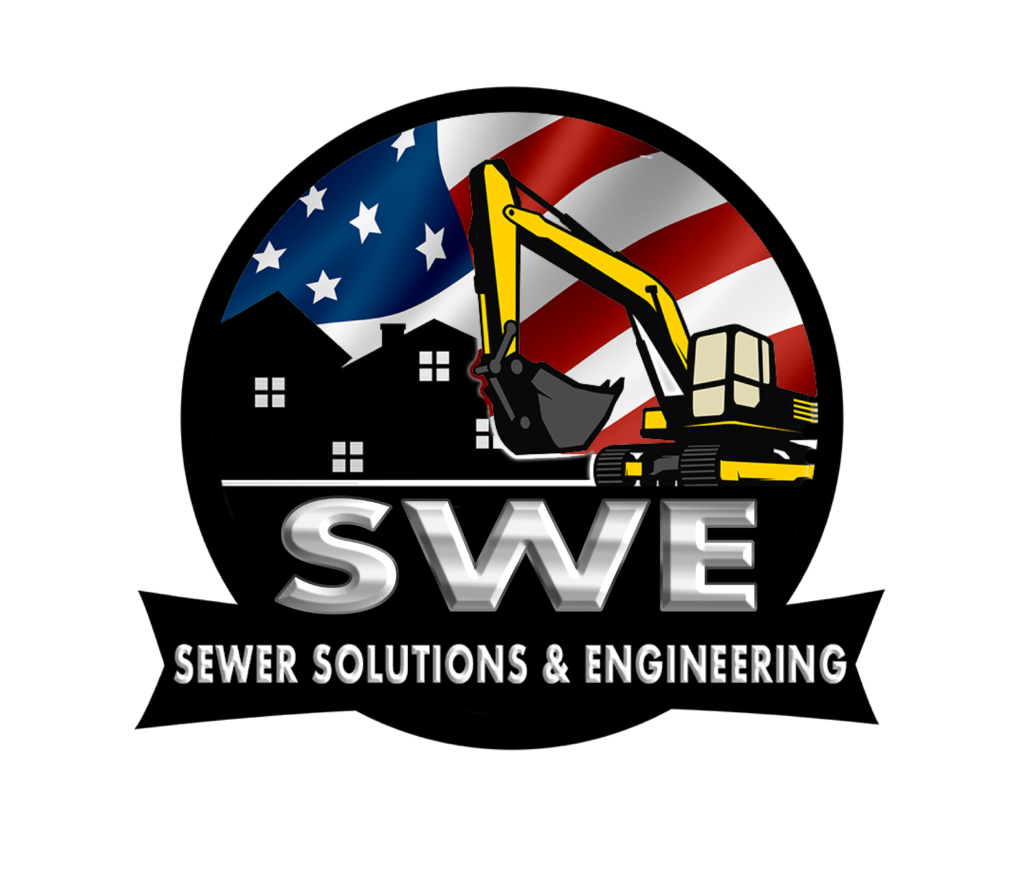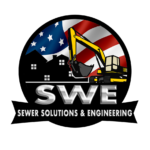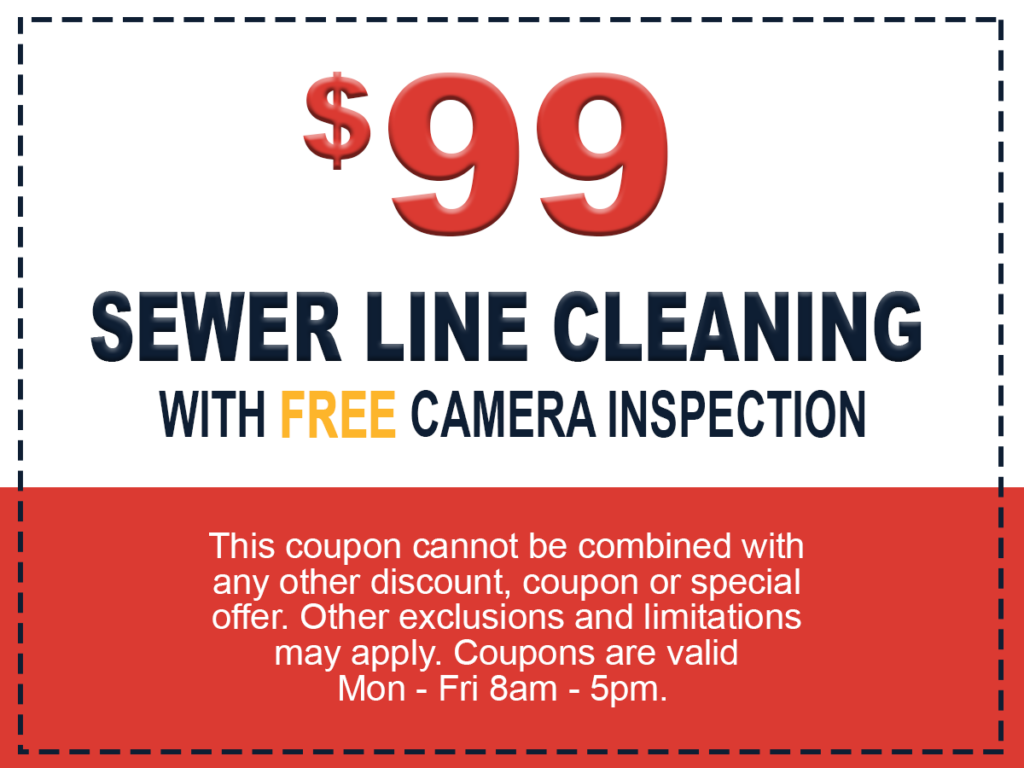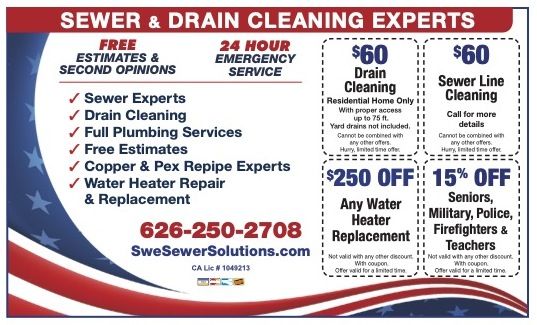Sewer Line Responsibility
In most cases, the city is responsible for sewer lines outside the property line and in public areas. However, homeowners should contact their local municipal sewer department for definitive information on responsibility for repairs, as it can vary by location and specific circumstances.
The city’s sewer line responsibility typically includes maintaining, repairing, and replacing the main sewer lines that run beneath public roads and connect to individual properties. These main lines, often referred to as public or municipal sewer lines, carry wastewater from private sewer connections to treatment plants.
The City is responsible for ensuring these systems function correctly, addressing issues like blockages, breaks, or leaks in the public sewer system. Additionally, the City is often tasked with establishing and enforcing codes and regulations that govern sewer line maintenance and repair to protect public health and environmental safety.
Schedule Service Online
Easy as 1-2-3
When is the City Responsible for Repairs?
To begin, we must first understand the general rule of thumb when it comes to sewer line responsibility. In most cases, the homeowner is responsible for the sewer lateral that runs from their property to the public main. This means everything in between falls under their care. Conversely, the city typically takes responsibility for the main sewer line running under public property. Let’s clarify what the “sewer lateral” really refers to. This term describes the underground pipes that connect a home to the main sewer line in the street.
These sewers are split into upper and lower laterals: the upper lateral runs from the home to the property line, while the lower lateral extends from the property line to the public main sewer line. Knowing these distinctions could be crucial in understanding liability for repairs. For instance, if there’s damage to your lower lateral outside your property line but not quite at the main sewer line, it could potentially fall under city jurisdiction rather than your own. Imagine it like this: if a tree root penetrated your lower lateral, causing blockage past your property boundary and beyond—the city would likely have greater jurisdiction over such a situation.
Navigating responsible parties can be confusing since every city might have its own regulations and policies regarding sewer repairs. Homeowners should definitely consult with their local city or municipal sewer department for definitive information on who is responsible for what. These departments can provide valuable insights into local laws and guidelines that help homeowners understand what they’re liable for and what they’re not.
For example, under the most current Los Angeles County Code, Section 20.24.080, it is the property owner’s responsibility to maintain and repair their sewer lateral up to the point of connection with the public sewer main, including the portion of the sewer lateral beneath the sidewalk and street. Understanding these nuances can make all the difference when addressing sewer problems, ensuring homeowners can navigate these issues effectively. With a solid grasp of sewer line responsibility under our belts, it’s time to turn our attention to determining the primary culprits behind potential main line issues.
Note: Most city’s and counties typically have their own code and regulations regarding sewer line responsibility. These codes outline the specific sewer line responsibilities of property owners and local governments concerning the maintenance, repair, and replacement of sewer lines. They can vary significantly depending on the location, as factors such as local infrastructure, environmental considerations, and public health regulations influence these rules. In general, local codes define the portion of the sewer system that property owners are responsible for, which often includes the sewer lines from the home to the main sewer line or water main.
Additionally, these codes may address issues like required permits for repairs, approved materials and construction methods, and specific procedures for addressing sewer backups or leaks. Understanding and complying with these local codes is essential for homeowners to ensure they fulfill their responsibilities and avoid potential legal or financial liabilities.
Understanding Sewer Line Responsibility: A Homeowner's Guide
Sewer line responsibility is a crucial aspect of homeownership that can often be overlooked until a problem arises. Understanding who is responsible for maintaining and repairing the various components of the sewer system can save homeowners from unexpected repair costs and potential water damage.
The sewer system includes various parts such as drains, drain pipes, wastewater pipes, and sewage pipes. Homeowners are typically responsible for the sewerage lines running from their home to the main connection at the road or water main. This includes the drain lines beneath their property, leading to the water meter. These lines carry waste from toilets, tubs, and sinks, eventually reaching a treatment plant. It’s essential to maintain these lines to prevent sewer backups, which can cause significant damage and health hazards.
A key component in the sewer system is the cleanout, an access point usually found in the yard. This access point allows for easy inspection and cleaning of the sewer lines, helping to prevent clogs caused by items like grease and toilet paper. Regular drain cleaning is necessary to maintain the proper flow of wastewater and avoid potential issues.
When a blockage or damage occurs, determining who is responsible can sometimes be confusing. Homeowners should know that their responsibility generally extends from their home to the main sewer line. Issues within this range, such as a clogged or broken drain pipe, fall under the homeowner’s coverage. However, the responsibility may shift to the local municipality or utility company if the problem occurs beyond the water main.
Understanding coverage for sewer line repairs is also vital. Not all insurance policies cover sewer pipe issues, so reviewing your policy and considering additional coverage if necessary is wise. Repair costs can be significant, especially if a problem affects the neighborhood or requires road excavation. Moreover, homeowners should be mindful of renovations or landscaping projects, as disturbing the sewer line can lead to costly repairs.
Preventative measures, such as avoiding flushing non-biodegradable items and regularly inspecting the system, can prevent many common issues. Homeowners should also communicate with their neighbors to understand the sewer line layout in their neighborhood. This awareness can be beneficial, especially if a problem affects multiple properties.
In conclusion, understanding sewer line responsibility is crucial for homeowners. Proper maintenance, regular cleaning, and awareness of potential issues can prevent costly repairs and ensure the smooth functioning of the sewer system.
Main Line Issue Determinants
Main line sewer issues unveil an array of crucial factors that determine the responsibility for resolving these problems. When it comes to identifying who is accountable for mainline sewer problems, here are some key points to consider.
The Location: A critical aspect in determining responsibility for mainline sewer issues is the physical location of the problem. If the issue occurs within public property, including streets or public easements, it’s typically considered the responsibility of the municipal authorities.
The severity of the Problem: Problems such as clogs, collapses, or leaks in the main line can vary in severity. For instance, minor clogs may not be seen as a pressing issue for the city to address, whereas severe collapses or significant leaks would likely fall under the purview of public responsibility.
Impact on Public Infrastructure: If a sewer issue has the potential to cause significant damage to public infrastructure like streets and sidewalks, it’s more likely that repairing it lies with the city. The ability of such issues to affect larger areas and multiple properties often makes them a concern beyond individual homeowners.
Determining responsibility for mainline sewer issues involves a multifaceted evaluation that considers various elements such as location, severity, and implications for public infrastructure. Compliance with local ordinances and regulations also plays a vital role in determining whose duty it is to rectify main-line sewer problems.
Issues like clogs, collapses, or leaks in this main line are typically addressed and managed by the municipal sewer department.
Having a comprehensive understanding of these determinates will provide clarity when addressing mainline sewer issues and ensure adherence to regulatory guidelines. As we navigate through the complex landscape of sewer line responsibilities, it’s essential to understand how each party shares accountability when dealing with these critical components of residential infrastructure.
Homeowner vs City: Sewer Line Ownership
There’s this labyrinth under your property that you might not know much about—the sewer lines. Just like a spider web connects one point to another, the underground pipes join your property to the main sewer line. But what’s confusing for most homeowners is figuring out who actually owns these snakelike paths of runoff from your house and whether they or the city are responsible for fixing any problems.
Most of the time, homeowners are on the hook for maintaining and repairing the pipes that run from their property to the public sewer line. It’s akin to how you need to take care of the driveway and walkway leading up to your house—it’s just part of being a homeowner.
Before donning your plumber hat, it’s crucial to find out exactly where your responsibilities end and the city’s begins. Generally, cities are in charge of the main sewer lines located in public areas and handle their care and repairs. The specifics can vary depending on local regulations, so it’s essential to consult your city’s sewer department or ordinances for precise information on what you should be responsible for.
If you’re unsure where your responsibility ends and the city’s begins, always start by finding out whom to contact to obtain the definitive information. In many cases, calling your city’s sewer department can provide clarity on who holds responsibility for various portions of the sewer system.
By knowing these ownership boundaries from the outset, homeowners can avert costly repairs when issues with their home’s sewer lines arise. Understanding the nuances of homeowner and city responsibilities sets the stage for comprehending the intricacies of damages and liability in relation to sewer lines.
Damages and Liability
When it comes to sewer line issues, determining the responsible party can be somewhat complicated. Homeowners typically bear the financial burden of repairing any damage to their property’s sewer lines. This responsibility extends to both upper and lower sewer laterals, which connect homes to the main city sewer line. However, if the problem originates from the main city sewer line, the city may be liable for damages or repairs directly related to it.
One thing to emphasize here is the distinction between private sewer lines within a homeowner’s property boundaries and the larger municipal sewer system. The upper lateral runs from the home to the property line, while the lower lateral extends from the property line to the main city sewer line. As mentioned earlier, homeowners are usually responsible for repairs to both sections.
Even if you believe that the issue is with the public sewer system, it’s essential to carefully review your homeowner’s insurance policy. Some policies cover damaged sewer lines under certain conditions, which could potentially alleviate some of the financial burden resulting from necessary repairs.
Here’s an example: Imagine identifying a backup in your home’s plumbing system and assuming it’s due to a problem in your own pipes. You call a plumber who determines that tree roots have invaded your lower lateral sewer line (the part that stretches from your property line to the municipal connection) due to cracks or fractures. At this point, most homeowners would naturally assume that they’re responsible for getting these damages fixed since it falls within their property lines. In these situations, seeking a second opinion from a professional could be helpful.
The key takeaway here is not just identifying the problem but also being prepared financially and knowing what possible support and recourse options are available. It underscores the importance of understanding one’s responsibilities as a homeowner and taking proactive steps to address potential issues before they escalate. The complexity of repair and maintenance responsibilities along a homeowner’s property highlights how intricate this process can be.
Common Causes of Sewer Damage
Sewer problems can lead to messy, unpleasant situations, so it’s important to get to the heart of what actually causes these issues. One of the most common sources of sewer damage is aging infrastructure; over time, sewer lines can deteriorate, crack, or collapse due to natural wear and tear. This can be exacerbated by factors such as ground shifting or settling, adding stress to the sewer pipes.
Another frequent offender causing sewer issues is tree root intrusion. While trees are lovely, their roots can cause big problems. They often grow into sewer lines through small cracks, looking for water or nutrients. As they enter, they can clog up the pipes and cause blockages, leading to backups and slow drainage.
Blockages in the city’s sanitary main system can also cause problems for homeowners. When this happens, sewage has nowhere to go and creates a backup into properties. Combined sewers designed to handle both stormwater and sewage also have a higher risk of becoming overwhelmed during heavy rains, leading to sewage backing up into basements or low-lying areas.
Additionally, corroded or deteriorating pipes can cause significant issues. Corrosion can happen due to environmental factors or even poor materials used in the original construction of the sewer system. Over time, this corrosion eats away at the pipes, making them more prone to cracking and collapsing.
Now imagine understanding what could cause these kinds of problems. Knowledge is power – being aware of these causes helps homeowners recognize potential risks and take measures to prevent them.By understanding the root causes of sewer line damage, homeowners are better equipped to recognize potential issues early and take steps to prevent costly repairs down the line.
Understanding sewer line responsibility maintenance falls on homeowners versus the city provides clarity, but navigating repairs and replacements can seem daunting. Let’s navigate this aspect next.
A few of the services we offer
Our licensed plumbers know how to safely and effectively use trenchless pipe lining equipment to fix, hard to get to, broken and crumbling pipes.
Our services meet the strict requirements of the State of California, and all of our contractors have their city business licenses.
If you’re looking for a sewer subcontractor that can handle all of your plumbing needs, you have come to the right place.
Trenchless Pipelining is a way of restoring severely damaged pipes, without digging. It’s a four step process of inserting a tube within the old pipe.
We have a great record of producing quality and a reputation for excellence. We assist with hooking up septic systems to modern sewage services offered by municipalities throughout Southern California.
The robotic cutter can easily navigate the rehabbed mainlines. It simply travels up into a section of pipe and removes any intruding lateral or reopens the branch lines without the need for excavation.
Managing Repairs and Replacements
Now that you know who’s accountable for the repairs, it’s crucial to address any issues promptly. When it comes to sewer line repairs or replacements, expertise is paramount. The process can be complex, requiring specialized knowledge and professional equipment.
To start, ensure that the contractors you’re considering are licensed and bonded. This validates their qualifications and commitment to quality service. Additionally, experience is key. Look for professionals who have a proven track record in effectively addressing sewer line issues. Their prior work history assures you that they are well-versed in handling diverse problems.
When considering different contractors, thoroughly review customer feedback and reviews about their performance. Satisfied customers often detail their experiences, providing valuable insights into a contractor’s reliability and quality of work. It also helps get a good gauge if the contractor prioritizes customer satisfaction and offers efficient solutions.
It’s crucial to request multiple estimates from different reputable contractors to compare services offered and associated costs. Doing this will guide your decision-making process towards choosing a contractor who not only guarantees quality workmanship but also aligns with your budget requirements.
For instance, SWE Sewer Solutions is a reputable contractor you can consider for your sewer line repair needs. With over 40 years of experience, the company has consistently delivered effective solutions for all types of sewer-related issues—from routine inspections to complex repairs and replacements. They prioritize customer satisfaction, offering free estimates, 24-hour emergency services, and utilizing state-of-the-art equipment.
Ensuring that you hire a skilled and experienced professional for your sewer line repairs can make a significant difference in the efficiency and effectiveness of the repair or replacement process while maximizing the value of your investment. Now, let’s explore the city’s responsibilities for repairs to gain further clarity on this critical aspect of maintaining sewer systems.
City's Accountabilities for Repairs
The responsibility for sewer line repairs can be a bit perplexing. Homeowners may not always have to foot the bill when it comes to fixes. The general rule is that property owners are responsible for maintaining and repairing the sewer lateral line on their private property. This means that even if the damage occurs beyond your property line before it connects to the main public sewer line, you’ll typically be responsible for the needed repairs.
However, there’s an exception to this rule. When problems arise with the main sewer line that runs through public properties, such as streets, sidewalks, or other public areas, it’s usually the city’s responsibility to address repairs. If you’re unsure about who is accountable for the necessary repairs, contacting your local city or municipal sewer department is essential. They can validate the city’s responsibilities and provide precise information concerning repairs of public sewer lines, putting you in a position to make informed decisions.
It’s important to recognize that these distinctions are vital. Being well-informed can save homeowners from undue stress or unexpected expenses in case of sewage issues. Understanding who is liable for what can prevent potential disputes and unnecessary financial burdens.
So, in short, if you’re uncertain about who should cover the costs of repairing a sewer line issue, your best bet is to contact your local city or municipal sewer department for guidance. By partnering with them and seeking accurate information on repairs of public sewer lines, you’ll be better equipped to tackle any issues that may arise without encountering unnecessary headaches or financial hardship later on. Clarity is key to navigating the labyrinthine landscape of sewer line responsibilities. The next stop on our journey delves into the legal recourses available against city liabilities.
Legal Recourses against City Liabilities
Navigating legal matters can be challenging, particularly when it comes to holding the city accountable for sewer line issues. Pursuing legal action or claims may seem appropriate if there is a belief that the city bears responsibility. However, taking legal action against a municipality or city entity requires specific procedures and regulations to be followed.
The first step is to seek guidance from professionals well-versed in municipal law and experienced in representing clients in cases involving municipal liability. Legal counsel can provide comprehensive guidance and assess the viability of pursuing legal action against the city for sewer line issues. Municipalities are often protected by certain immunities and limitations on liability under state laws. Understanding these legal frameworks and their implications is vital as it sets realistic expectations for potential outcomes.
Documentation and evidence play a critical role in establishing a case against the city for sewer line problems. This can include records of previous repairs, maintenance efforts, communications with local authorities, and any relevant reports or assessments.
When contemplating legal action against the city for sewer line issues, seeking professional guidance early on is essential. Skilled attorneys specializing in municipal law can provide valuable insight and help navigate through the intricacies of pursuing accountability from city entities. It’s about building a strong case based on comprehensive knowledge of municipal laws and regulations.
If you’re facing sewer line issues and considering legal action against the city, seeking professional guidance is vital. Contact SWE Sewer Solutions for expert advice and reliable sewer services.
Questions You Should be Asking Yourself
What factors determine if the city is responsible for maintaining the sewer line?
The city is generally responsible for maintaining the sewer line if it is located within public property, such as streets and sidewalks. Factors such as the location of the line, ownership status, and local regulations play a role in determining responsibility. According to a survey conducted by the National League of Cities, 82% of cities surveyed are responsible for maintaining sewer lines located within public rights-of-way.
How can homeowners determine if they are responsible for their sewer line?
Homeowners can determine if they are responsible for their sewer line by checking their local municipality’s guidelines and regulations. Typically, homeowners are responsible for the sewer line that connects their property to the main municipal sewer line. Additionally, if there is a sewer line service agreement with the city, it may outline specific responsibilities. It is important to consult with local authorities or review municipal codes and agreements to determine individual responsibility.
What should homeowners do if they suspect a problem with their sewer line and are unsure of who is responsible?
Homeowners who suspect a problem with their sewer line and are unsure who is responsible should first contact their local public works department or utility provider. They can provide guidance on whether the issue falls under the city’s responsibility or the homeowner’s responsibility. According to a recent survey by the National Association of Home Builders, approximately 73% of cities have specific policies in place for determining sewer line responsibility, highlighting the importance of reaching out to the appropriate authorities for clarification.
Are there any legal obligations or regulations that dictate when the city becomes responsible for the sewer line?
Yes, there are legal obligations and regulations that determine when the city becomes responsible for sewer line repairs. In most cases, the city is responsible for maintaining and repairing the main sewer lines that run through public property or streets. However, the responsibility can vary depending on municipal laws and specific circumstances. It’s important to consult local ordinances and seek legal advice for accurate information regarding a particular situation.
Are there any specific circumstances where the responsibility for the sewer line shifts from homeowners to the city?
Yes, there are specific circumstances where the responsibility for the sewer line shifts from homeowners to the city. One common scenario is when the damage or blockage originates from a municipal sewer main or lateral line.
According to a study conducted in 2022, approximately 30% of sewer line issues are caused by problems beyond homeowners’ control, such as tree root intrusion into municipal lines or aging infrastructure failures. In these cases, the city is responsible for repairs and maintenance.
Learn more about Los Angles County Public Works at https://pw.lacounty.gov/
Benefits of Hiring a Local Sewer Expert
There are several benefits to hiring a qualified sewer expert in your area, including helping out your community so that the dollars stay local. However, a more important benefit is that you can be sure the job will be completed properly and always up to code. Additionally, when choosing SWE, you can trust that our skilled technicians are equipped with the knowledge and tools needed to tackle any plumbing issue.
No matter if it’s a simple valve replacement, a faucet leak in the kitchen, a bathroom sink or shower head leaking, a drain clog, a garbage disposal, a hot water heater issue, or a malfunctioning toilet. We also provide plumbing and sewer services, that include gas line inspections, leak detection, sewer line repair, drain clogs, hydrojetting, video camera inspections, and much more.
Do you need to replace your sewer lines, connect your home’s sewer system to the city sewage, or have any other residential or commercial plumbing needs? SWE Sewer Solutions Construction and Engineering is your local plumbing service and one of a very few family-owned, professional, and affordable plumbing companies.
As a homeowner, it’s natural to have questions about residential plumbing issues, but with a skilled plumber by your side, you can be sure that all your concerns will be addressed with expertise and that you can expect the best results from our plumbing services at the lowest prices. Our team is always ready for any plumbing repair.
We are available 24/7 for any emergency plumbing service you need. We understand plumbing issues can sometimes not wait or be postponed, so we are always ready for your call and ready when you most need help. Emergency situations such as your basement flooding require that you have a sump pump ready; otherwise, things can get really messy. We are ready to handle these types of situations. We are your local emergency plumber.
Our plumbing experts are bonded and insured. Call us today if you need more information, have questions, need a price quote, or if you need to schedule an inspection. No matter what the service, you can rest assured that any warranties on your equipment will remain valid for the life of its warranty. Schedule an appointment for a free in-house estimate, or message us if you prefer.
Finally, if you are looking to hire a qualified local contractor or plumber for a complete inspection of your home or business, give us a call. We are a family-owned and operated sewer service and plumbing company that has been in business since 1980.
We have the resources to team up with other contractors on larger projects. We cover all of the local areas in and around Southern California. Ask about our free estimates. We look forward to delivering the best customer care. Please check out our customer reviews and ratings.




